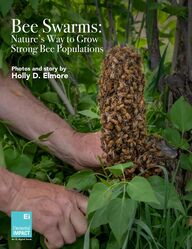
Return to flip book view
Message Bee Swarms: Nature’s Way to Grow Strong Bee PopulationsPhotos and story by Holly D. ElmoreAn Ei digital book
Bee Swarms: Nature’s Way to Grow Strong Bee PopulationsHoneybee swarming is integral to colony propagation and overall bee population stabilization and growth. Within the intricate colony organization, a powerful collective consciousness develops among the bees. When a colony senses that the current space is limiting growth, a collective decision is made to divide into two or more colonies via swarming. en preparations begin for the prime swarm.As a rst step in swarm preparation, the queen lays eggs in queen cups prepared by worker bees. When the queen departs with the prime swarm, a new queen is “in waiting” to rule the existing hive. An egg-laying queen is too heavy to y easily. us, the second swarm preparation step is to cut back on food given to the queen. As she loses weight, the queen stops laying eggs. Once the queen loses enough weight for ight, the bees destined for swarming ll their bellies with food from the hive. e swarm preparation is complete.In a dramatic natural event, 50 to 60 percent of the colony bees leave the hive with the queen in a prime swarm. Up to tens of thousands of bees sele in a nearby interim location while scouts search for the new hive. It is a fragile time for the swarm because the bees are unprotected from weather conditions and have only the food in their bellies for survival. With astonishing communication skills, the scouts report back on potential hive locations, and a debate ensues. Once a location decision is made, the swarm leaves the interim location for the new home.Back at the original hive, the rst queen to hatch kills the remaining unhatched queens with the help of worker bees. e young virgin is the new queen of the hive. It is a vulnerable time for the hive as it reestablishes order for the remaining bees. Due to the swarm preparation, the former queen stopped laying eggs for the hive, causing a lag in worker bee reproduction. e remaining bees may decide to swarm in a smaller secondary event called an “aer swarm.” On rare occasions, there may be multiple aer swarms, leaving the original hive empty.Prime swarms double the number of colonies along with providing sucient hive space to reestablish a strong bee population in both the new and original hives. Swarming is nature’s way to grow strong honeybee populations in number of colonies and individual bees. hPhotos and story by Holly D. ElmoreSource: Why and How Bees Swarm, PerfectBee.com
A beekeeper discovers the interim location for a prime swarm of about 8,000 bees from one of his nearby hives. With patient tenacity, he removes the swarm from his neighbor’s lilac bush and gently coaxes the bees into a new hive. As they are docile, the beekeeper elects to use his bare hands while he works with the bees. Once the bees are safely nestled in the hive, the beekeeper inserts honeycombs for food and comfort and covers the hive. e covered hive is le by the lilac bush overnight for the scout bees to rejoin the swarm.
In partnership with Holly Elmore Enterprises, Elemental Impact (Ei) is building a digital library comprised of Holly’s Fingertip Press publications supported by Holly Elmore Images photos. Created and published by Nancy Suttles, the digital books augment Ei’s profound work within the Soil Health and Water Use | Toxicity platforms.Click here to see Holly Elmore Images VideoFARM GARDENSOUTHERN™&As featured in the Summer 2018 issue of:Nancy Suttles, Publisher & Creative Director